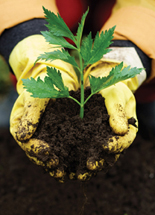Module 1 Intro
1. Module 1 Intro
1.23. Page 2
Module 1—Energy Flow and the Cycling of Matter
 Explore
Explore
 Read
Read
How are primary producers connected to heterotrophs? Both are involved in providing necessary nutrients for each other. They both contribute to biogeochemical cycles. Reading page 42 of the textbook and page 43 up to “The Carbon and Oxygen Cycles” will introduce you to biogeochemical cycles and new vocabulary.

© Viktor Neimanis/iStockphoto
 Self-Check
Self-Check
SC 1. Answer question 7 on page 43 of your textbook.
SC 2. What biotic and abiotic components are directly available as nutrients?
SC 3. What biotic and abiotic components are indirectly available as nutrients?
 Self-Check Answers
Self-Check Answers
SC 1.
- Nutrients from slow cycling will eventually become a part of rapid cycling processes.
SC 2. Biotic components directly available as nutrients are living or recently living organisms. Atmosphere, soil, and water are abiotic components directly available as nutrients.
SC 3. Fossil fuels (fossilization) are biotic components, which are indirectly available as nutrients. Abiotic components indirectly available as nutrients are minerals in rock.
 Read
Read
Continue reading page 43 in the textbook, page 44 to the investigation, and page 46. Your textbook will introduce the carbon and oxygen cycles. On page 44 of the textbook, there is a "Web Link" with some wording and a link to an animation that will reinforce what has been presented in the textbook and highlight vocabulary. You may choose to watch the video first, or maybe you prefer to read something first and then watch a video. Try doing it one way, and then reverse the order. Decide which method is most helpful to you, and continue through the lesson.
The Recycling of Other Elements and Compounds
biogeochemical cycle: a diagram representing the movement of elements and compounds between living and non-living components of an ecosystem
In Lesson 3 you looked at how water is recycled through the biosphere. The idea of recycling also applies to other elements and compounds. The atoms of carbon, nitrogen, oxygen, phosphorus, and other elements that make up the bodies of living organisms are the same atoms present when life began on Earth. These materials must also be recycled. The processes involved in recycling the essential elements and compounds are referred to as biogeochemical cycles.
Although the word biogeochemical appears long, it is actually made up of three familiar parts—bio refers to life, geo refers to Earth, and chemical refers to elements and compounds. These cycles refer to the exchange between Earth and ecosystems of the elements essential to life.
This table gives a brief overview of the chemicals that you will be studying. The table also relates what these chemicals are used for in living organisms.
Element |
Used in the production of . . . |
|---|---|
carbon |
carbohydrates, fats, proteins, hormones, vitamins |
oxygen |
carbohydrates, fats, proteins, hormones, vitamins, required for cellular respiration |
nitrogen |
proteins, nucleic acid (e.g., deoxyribonucleic acid (DNA)) |
phosphorus |
cell membrane structural components, cellular energy molecules (e.g., adenosine triphosphate (ATP)) |